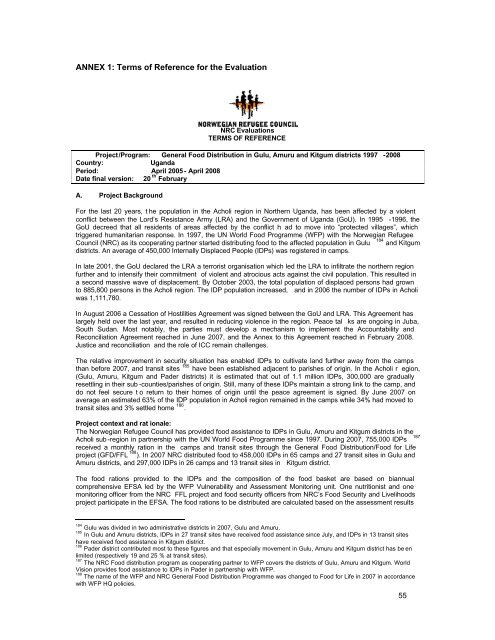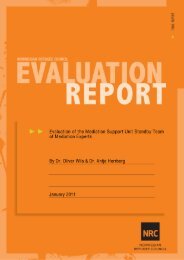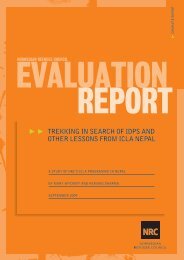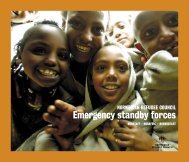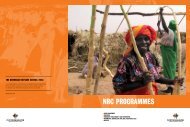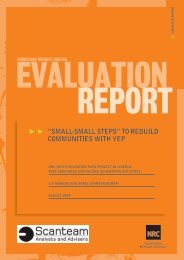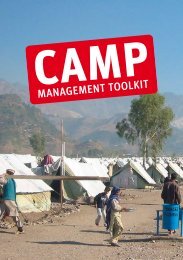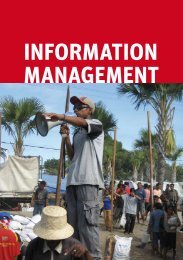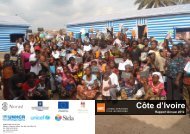evaluation of general food distribution in northern uganda: gulu ...
evaluation of general food distribution in northern uganda: gulu ...
evaluation of general food distribution in northern uganda: gulu ...
Create successful ePaper yourself
Turn your PDF publications into a flip-book with our unique Google optimized e-Paper software.
ANNEX 1: Terms <strong>of</strong> Reference for the EvaluationNRC EvaluationsTERMS OF REFERENCEProject/Program: General Food Distribution <strong>in</strong> Gulu, Amuru and Kitgum districts 1997 -2008Country:UgandaPeriod: April 2005 - April 2008Date f<strong>in</strong>al version: 20 th FebruaryA. Project BackgroundFor the last 20 years, t he population <strong>in</strong> the Acholi region <strong>in</strong> Northern Uganda, has been affected by a violentconflict between the Lord’s Resistance Army (LRA) and the Government <strong>of</strong> Uganda (GoU). In 1995 -1996, theGoU decreed that all residents <strong>of</strong> areas affected by the conflict h ad to move <strong>in</strong>to “protected villages”, whichtriggered humanitarian response. In 1997, the UN World Food Programme (WFP) with the Norwegian RefugeeCouncil (NRC) as its cooperat<strong>in</strong>g partner started distribut<strong>in</strong>g <strong>food</strong> to the affected population <strong>in</strong> Gulu184 and Kitgumdistricts. An average <strong>of</strong> 450,000 Internally Displaced People (IDPs) was registered <strong>in</strong> camps.In late 2001, the GoU declared the LRA a terrorist organisation which led the LRA to <strong>in</strong>filtrate the <strong>northern</strong> regionfurther and to <strong>in</strong>tensify their commitment <strong>of</strong> violent and atrocious acts aga<strong>in</strong>st the civil population. This resulted <strong>in</strong>a second massive wave <strong>of</strong> displacement. By October 2003, the total population <strong>of</strong> displaced persons had grownto 885,800 persons <strong>in</strong> the Acholi region. The IDP population <strong>in</strong>creased, and <strong>in</strong> 2006 the number <strong>of</strong> IDPs <strong>in</strong> Acholiwas 1,111,780.In August 2006 a Cessation <strong>of</strong> Hostilities Agreement was signed between the GoU and LRA. This Agreement haslargely held over the last year, and resulted <strong>in</strong> reduc<strong>in</strong>g violence <strong>in</strong> the region. Peace tal ks are ongo<strong>in</strong>g <strong>in</strong> Juba,South Sudan. Most notably, the parties must develop a mechanism to implement the Accountability andReconciliation Agreement reached <strong>in</strong> June 2007, and the Annex to this Agreement reached <strong>in</strong> February 2008.Justice and reconciliation and the role <strong>of</strong> ICC rema<strong>in</strong> challenges.The relative improvement <strong>in</strong> security situation has enabled IDPs to cultivate land further away from the campsthan before 2007, and transit sites 185 have been established adjacent to parishes <strong>of</strong> orig<strong>in</strong>. In the Acholi r egion,(Gulu, Amuru, Kitgum and Pader districts) it is estimated that out <strong>of</strong> 1.1 million IDPs, 300,000 are graduallyresettl<strong>in</strong>g <strong>in</strong> their sub -counties/parishes <strong>of</strong> orig<strong>in</strong>. Still, many <strong>of</strong> these IDPs ma<strong>in</strong>ta<strong>in</strong> a strong l<strong>in</strong>k to the camp, anddo not feel secure t o return to their homes <strong>of</strong> orig<strong>in</strong> until the peace agreement is signed. By June 2007 onaverage an estimated 63% <strong>of</strong> the IDP population <strong>in</strong> Acholi region rema<strong>in</strong>ed <strong>in</strong> the camps while 34% had moved totransit sites and 3% settled home 186 .Project context and rat ionale:The Norwegian Refugee Council has provided <strong>food</strong> assistance to IDPs <strong>in</strong> Gulu, Amuru and Kitgum districts <strong>in</strong> theAcholi sub -region <strong>in</strong> partnership with the UN World Food Programme s<strong>in</strong>ce 1997. Dur<strong>in</strong>g 2007, 755,000 IDPs 187received a monthly ration <strong>in</strong> the camps and transit sites through the General Food Distribution/Food for Lifeproject (GFD/FFL 188 ). In 2007 NRC distributed <strong>food</strong> to 458,000 IDPs <strong>in</strong> 65 camps and 27 transit sites <strong>in</strong> Gulu andAmuru districts, and 297,000 IDPs <strong>in</strong> 26 camps and 13 transit sites <strong>in</strong> Kitgum district.The <strong>food</strong> rations provided to the IDPs and the composition <strong>of</strong> the <strong>food</strong> basket are based on biannualcomprehensive EFSA led by the WFP Vulnerability and Assessment Monitor<strong>in</strong>g unit. One nutritionist and onemonitor<strong>in</strong>g <strong>of</strong>ficer from the NRC FFL project and <strong>food</strong> security <strong>of</strong>ficers from NRC’s Food Security and Livelihoodsproject participate <strong>in</strong> the EFSA. The <strong>food</strong> rations to be distributed are calculated based on the assessment results184Gulu was divided <strong>in</strong> two adm<strong>in</strong>istrative districts <strong>in</strong> 2007, Gulu and Amuru.185In Gulu and Amuru districts, IDPs <strong>in</strong> 27 transit sites have received <strong>food</strong> assistance s<strong>in</strong>ce July, and IDPs <strong>in</strong> 13 transit siteshave received <strong>food</strong> assistance <strong>in</strong> Kitgum district.186Pader district contributed most to these figures and that especially movement <strong>in</strong> Gulu, Amuru and Kitgum district has be enlimited (respectively 19 and 25 % at transit sites).187The NRC Food <strong>distribution</strong> program as cooperat<strong>in</strong>g partner to WFP covers the districts <strong>of</strong> Gulu, Amuru and Kitgum. WorldVision provides <strong>food</strong> assistance to IDPs <strong>in</strong> Pader <strong>in</strong> partnership with WFP.188The name <strong>of</strong> the WFP and NRC General Food Distribution Programme was changed to Food for Life <strong>in</strong> 2007 <strong>in</strong> accordancewith WFP HQ policies.55


